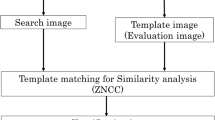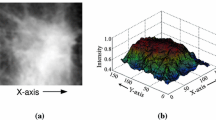Abstract
Mammographic risk assessment is concerned with the probability of a woman developing breast cancer. Recently, it has been suggested that the density of linear structures is related to risk. For 321 images from the MIAS database, the images were segmented in to dense and non-dense tissue using a method described by Sivaramakrishna, et al. In addition, a measure of line strength was obtained for each pixel using the Line Operator method. The above-threshold linearity was calculated in dense and non-dense tissue for each image and the images were then classified by BIRADS class using linear discriminant analysis. The results show a marked improvement when both density and linear structure information is used in classification over density information alone.
Preview
Unable to display preview. Download preview PDF.
Similar content being viewed by others
References
van Gils, C.H., Otten, J.D., Hendriks, J.H., Holland, R., Straatman, H., Verbeek, A.L.: High mammographic breast density and its implications for the early detection of breast cancer. Journal of Medical Screening 6, 200–204 (1999)
Wolfe, J.N.: Risk for breast cancer development determined by mammographic parenchymal pattern. Cancer 37(5), 2486–2492 (1976)
Kolb, T.M., Lichy, J., Newhouse, J.H.: Comparison of the performance of screening mammography, physical examination, and breast us and evaluation of factors that influence them: An analysis of 27,825 patient evaluations. Radiology 225(1), 165–175 (2002)
Tabár, L., Dean, P.B.: Mammographic parenchymal patterns. risk indicator for breast cancer? Journal of the American Medical Association 247(2), 185–189 (1982)
Gram, I.T., Funkhouser, E., Tabár, L.: The Tabár classification of mammographic parenchymal patterns. European Journal of Radiology 24(2), 131–136 (1997)
Tabár, L., Tot, T., Dean, P.B.: Breast Cancer - The Art and Science of Early Detection with Mammography. Georg Thieme Verlag, Stuttgart (2005)
Suckling, J., Parker, J., Dance, D., Astley, S., Hutt, I., Boggis, C., Ricketts, I., Stamatakis, E., Cerneaz, N., Kok, S., Taylor, P., Betal, D., Savage, J.: The mammographic images analysis society digital mammogram database. In: Exerpta Medica. International Congress Series, vol. 1069, pp. 375–378 (1994)
American College of Radiology: Illustrated Breast Imaging Reporting and Data System. 3rd edn. American College of Radiology (1998)
Sivaramakrishna, R., Obuchowski, N.A., Chilcote, W.A., Powell, K.A.: Automatic segmentation of mammographic density. Academic Radiology 8(3), 250–256 (1998)
Kittler, J., Illingworth, J.: Minimum error thresholding. Pattern Recognition 19(1), 41–47 (1986)
Dixon, R.N., Taylor, C.J.: Automated asbestos fibre counting. In: Institute of Physics Conference Series, vol. 44, pp. 178–185 (1979)
Zwiggelaar, R., Astley, S.M., Boggis, C.R.M., Taylor, C.J.: Linear structures in mammographic images: Detection and classification. IEEE Transactions on Medical Imaging 23(9), 1077–1086 (2004)
Hadley, E.M., Denton, E.R.E., Zwiggelaar, R.: Mammographic risk assessment based on anatomical linear structures. In: Astley, S.M., Brady, M., Rose, C., Zwiggelaar, R. (eds.) IWDM 2006. LNCS, vol. 4046, pp. 626–633. Springer, Heidelberg (2006)
Cohen, J.: A coefficient of agreement for nominal scales. Educ. Psychol. Meas. 20, 27–46 (1960)
Landis, J., Koch, G.: The measurement of observer agreement for categorical data. Biometrics 33(3), 159–174 (1977)
Oliver, A., Freixenet, J., Martí, R., Zwiggelaar, R.: A comparison of breast tissue classification techniques. In: Larsen, R., Nielsen, M., Sporring, J. (eds.) MICCAI 2006. LNCS, vol. 4191, pp. 872–879. Springer, Heidelberg (2006)
Karssemeijer, N.: Automated classification of mammographic parenchymal pattern. Physics in Medicine and Biology 28, 365–378 (1998)
Author information
Authors and Affiliations
Editor information
Rights and permissions
Copyright information
© 2007 Springer Berlin Heidelberg
About this paper
Cite this paper
Hadley, E.M., Denton, E.R.E., Pont, J., Pérez, E., Zwiggelaar, R. (2007). Risk Classification of Mammograms Using Anatomical Linear Structure and Density Information. In: Martí, J., Benedí, J.M., Mendonça, A.M., Serrat, J. (eds) Pattern Recognition and Image Analysis. IbPRIA 2007. Lecture Notes in Computer Science, vol 4478. Springer, Berlin, Heidelberg. https://doi.org/10.1007/978-3-540-72849-8_24
Download citation
DOI: https://doi.org/10.1007/978-3-540-72849-8_24
Publisher Name: Springer, Berlin, Heidelberg
Print ISBN: 978-3-540-72848-1
Online ISBN: 978-3-540-72849-8
eBook Packages: Computer ScienceComputer Science (R0)




